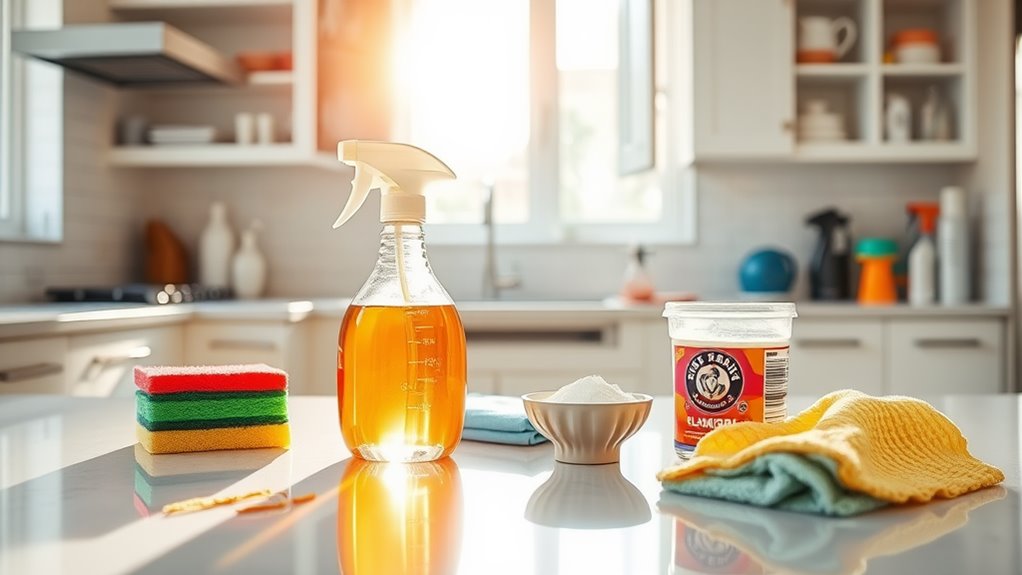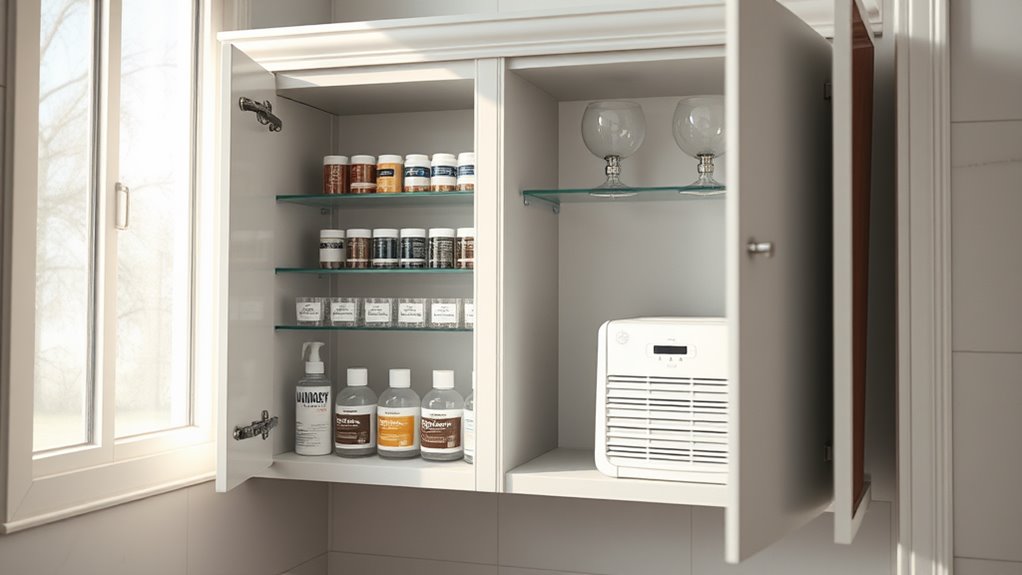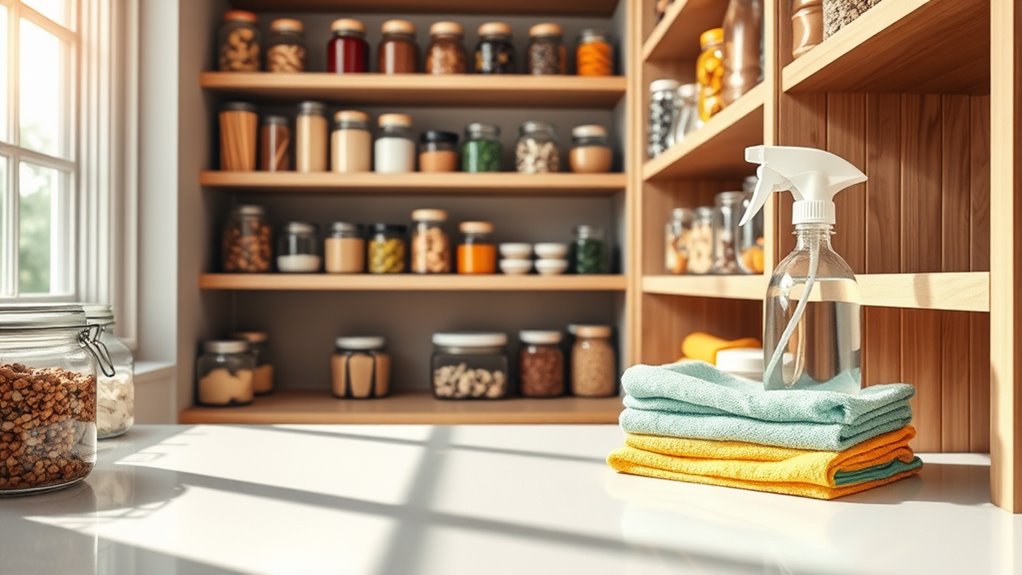7 Quick Cleaning Hacks That’ll Save You HOURS Every Week
You can save hours on cleaning each week with these seven quick hacks. Use baking soda for deodorizing surfaces and speed up dusting with a microfiber cloth for better results. Create a cleaning caddy for easy access to supplies and set a timer for quick cleaning sessions to boost your efficiency. Don’t forget the one-minute rule to tackle small messes right away. Also, use vinegar for streak-free windows and develop a smart folding strategy for laundry. There’s so much more to simplify your cleaning routine!
Key Takeaways
- Set a timer for 15-30 minutes to tackle cleaning tasks efficiently and boost productivity.
- Use baking soda to deodorize carpets and surfaces quickly, neutralizing odors without harsh chemicals.
- Employ the “W” dusting technique with a damp microfiber cloth for effective dust capture and coverage.
- Create a portable cleaning caddy with essential supplies for quick access during cleaning sessions.
- Apply the one-minute rule to address small messes immediately, preventing clutter buildup and saving time later.
Use Baking Soda for Deodorizing Surfaces
When you want to freshen up your home, using baking soda is a simple yet effective solution. This versatile powder works wonders as a deodorizer for various surfaces. Baking soda not only neutralizes odors but also absorbs moisture, making it an excellent choice for damp areas like bathrooms. Additionally, baking soda’s pH level helps break down grime and stains, enhancing its cleaning capabilities.
Sprinkle baking soda on carpets, let it sit for 15 minutes, then vacuum it up to eliminate odors. For kitchen surfaces, create a paste with water and apply it to stubborn stains; after a brief wait, wipe it clean. Using baking soda weekly can also help achieve a sparkling sink by preventing buildup and water spots. In the fridge, place an open box of baking soda to neutralize unpleasant smells, as it can absorb refrigerator odors effectively. These cleaning hacks not only enhance your home’s freshness but also save you time and effort. Additionally, baking soda can be used to unclog kitchen drains when combined with vinegar, providing a natural alternative to chemical cleaners.
Mastering the art of deodorizing with baking soda can transform your cleaning routine, making it a powerful ally in your quest for a pristine environment.
Speed up Dusting With a Microfiber Cloth
Using a microfiber cloth can really change your dusting game.
You’ll not only enjoy its benefits, like trapping dust effectively, but also discover techniques that make cleaning quicker and easier. For instance, incorporating smart shortcuts can greatly reduce the time you spend dusting. Additionally, focusing on high-impact tasks will allow you to maintain a tidy living space with minimal effort. It’s important to avoid common cleaning mistakes, such as using the wrong cleaning products, which can lead to ineffective cleaning results. Furthermore, the use of microfiber cloths is recommended because they are safe cleaning alternatives that won’t damage surfaces. Plus, with the right maintenance, your microfiber cloth will last for a long time, keeping your home dust-free. Innovative cleaning shortcuts can further enhance your dusting efficiency, making your chores even less time-consuming.
Benefits of Microfiber Cloth
While dusting may seem like a tedious chore, employing a microfiber cloth can transform the task into a quick and efficient process.
These cloths are designed with tiny fibers that trap dust and dirt, preventing them from scattering back into the air. You’ll find that microfiber isn’t only highly absorbent but also effective at picking up allergens, making your space cleaner and healthier.
Plus, they’re reusable and can withstand countless washes without losing their effectiveness, saving you money in the long run.
By switching to microfiber, you’ll reduce your cleaning time considerably and achieve superior results.
Harness the power of these versatile cloths, and elevate your dusting game to a level of mastery you’ll appreciate.
Dusting Techniques to Try
Five effective dusting techniques can help you maximize the power of your microfiber cloth, making the process quicker and more efficient.
First, always dust from top to bottom; this prevents dust from settling on already-cleaned surfaces.
Second, use a damp microfiber cloth for sticky spots; the moisture captures more particles.
Third, employ the “W” technique, sweeping the cloth in a zigzag motion, ensuring full coverage.
Fourth, tackle electronics with a dry microfiber cloth to avoid streaks and dust buildup.
Finally, don’t forget to regularly shake out or wash your cloth to maintain its effectiveness.
Maintenance for Longevity
To keep your microfiber cloth effective and speed up your dusting routine, regular maintenance is key. Neglecting your cloth can lead to less efficient cleaning and the spread of dust.
Follow these steps to guarantee longevity and peak performance:
-
Wash regularly: Clean your microfiber cloth in warm water without fabric softeners to avoid residue.
-
Air dry: Skip the dryer; instead, hang your cloth to dry to preserve its fibers.
-
Store properly: Keep your microfiber cloth in a dry, clean place, avoiding exposure to dust and dirt.
-
Inspect frequently: Check for wear and tear; replace it when it loses its effectiveness.
Create a Cleaning Caddy for Easy Access
Creating a cleaning caddy not only streamlines your cleaning routine but also guarantees you have everything you need at your fingertips. Start by selecting a sturdy, portable container—like a tote or a bucket. Fill it with your essential cleaning supplies: multipurpose cleaner, glass cleaner, microfiber cloths, sponges, and a scrub brush. By establishing a 10-minute daily cleaning routine, you can maintain a clutter-free environment and make your cleaning sessions more manageable. Having a smart tool like a caddy allows for quick transitions between tasks, making your cleaning process even more efficient.
Incorporating a balanced weekly schedule into your cleaning routine can help distribute tasks evenly throughout the week. Additionally, organizing your supplies in a way that prioritizes frequently used items can enhance small-space storage efficiency. Don’t forget gloves and a small trash bag for quick disposal.
This setup allows you to move effortlessly from room to room, tackling messes with efficiency. By having all your supplies in one place, you’ll save time and maintain focus, ultimately mastering your cleaning tasks with ease and precision. Additionally, using natural ingredients in your supplies can enhance the effectiveness of your cleaning routine while being budget-friendly.
Set a Timer for Quick Cleaning Sessions
Setting a timer for quick cleaning sessions can transform how you tackle chores.
By focusing on effective time intervals, you’ll boost your productivity and stay motivated.
Plus, breaking tasks into manageable chunks makes cleaning less overwhelming and more efficient.
Benefits of Timed Cleaning
Timed cleaning can transform your approach to tidying up, making it feel less intimidating and more manageable. By setting a timer, you create a focused environment that enhances productivity and minimizes distractions.
Here are some key benefits:
- You’ll develop a sense of urgency, prompting you to work more efficiently.
- It helps break down overwhelming tasks into bite-sized sessions.
- You’ll notice improved motivation, as progress becomes instantly rewarding.
- Regular timed sessions can establish a consistent cleaning routine that sticks.
Embracing timed cleaning can redefine your cleaning strategy, allowing you to master your space without the dread that often accompanies household chores.
You’ll find it’s not just about speed; it’s about creating a productive mindset that makes cleaning feel effortless.
Effective Time Intervals
To make the most of your cleaning sessions, choosing effective time intervals is key. Set a timer for 15 to 30 minutes, depending on the task. This focused approach not only boosts your productivity but also makes cleaning feel less intimidating.
You’ll be amazed at how much you can accomplish in just a short burst of time. Try breaking larger tasks into smaller segments; for example, tackle one room or area at a time. Use a timer to create urgency, pushing yourself to complete each task efficiently.
Don’t forget to take a short break after each interval to recharge. Establishing these effective time intervals transforms cleaning from a challenging chore into a manageable routine, keeping you on track and motivated.
Focused Cleaning Tasks
While cleaning can often feel overwhelming, focusing on specific tasks for short bursts can make a big difference.
By setting a timer for 15 or 30 minutes, you’ll sharpen your focus and achieve more in less time.
Here are some tasks to tackle during these focused sessions:
- Dust surfaces in one room
- Wipe down kitchen counters and appliances
- Vacuum high-traffic areas
- Organize a cluttered drawer or shelf
Implement the One-Minute Rule
If you notice a small mess that’ll only take a minute to clean up, don’t hesitate—just tackle it right away. This approach, known as the One-Minute Rule, helps you maintain a clean environment without letting clutter accumulate.
Whether it’s wiping down a countertop, putting away shoes, or sorting mail, these quick tasks prevent larger messes from developing. By committing to this rule, you’ll cultivate a habit of efficiency and mindfulness in your cleaning routine.
You’ll find that addressing minor issues immediately frees up your time and mental space later. Plus, the satisfaction of keeping your space tidy reinforces your commitment to mastering your environment.
Embrace this simple yet powerful rule, and watch your cleaning efforts transform.
Use Vinegar for Streak-Free Windows
A simple solution for achieving streak-free windows lies in using vinegar. This natural cleaner cuts through grime and leaves your glass sparkling.
To master this technique, follow these steps:
- Mix equal parts of white vinegar and water in a spray bottle.
- Spray the solution onto your windows, starting from the top and working your way down.
- Use a microfiber cloth or a squeegee for an even finish, wiping in a circular motion.
- For extra shine, buff with a clean, dry cloth after cleaning.
Tackle Laundry With a Folding Strategy
To keep your laundry organized and manageable, developing an effective folding strategy is essential. Start by sorting your clothes into categories—like shirts, pants, and towels—before folding. This not only streamlines the process but also helps you keep track of what you have.
Use a flat surface for folding, and consider mastering techniques like the Marie Kondo method or the traditional fold for crisp edges. Always fold immediately after drying to prevent wrinkles.
For extra efficiency, designate a space for clean laundry and a separate one for items needing attention. Finally, involve your family in the folding process; it’s a great way to share the load and teach kids valuable skills.
With consistency, you’ll save time and maintain order effortlessly.
Frequently Asked Questions
How Often Should I Clean My Home Using These Hacks?
You should clean your home regularly, ideally weekly, to maintain a tidy environment. Incorporate these hacks into your routine, and you’ll notice how much easier and quicker cleaning becomes, giving you more time for yourself.
Can Children Help With These Quick Cleaning Methods?
You can involve children in these quick cleaning methods. Assign age-appropriate tasks, like dusting or organizing toys, and they’ll not only learn responsibility but also make cleaning a fun family activity together.
What Are Some Eco-Friendly Alternatives to Common Cleaning Products?
You can easily swap harsh cleaners for eco-friendly alternatives. Try vinegar, baking soda, and essential oils for effective cleaning. They’ll tackle grime without harmful chemicals, benefiting both your home and the environment. Embrace sustainability!
How Do I Create a Cleaning Schedule That Incorporates These Hacks?
To create an effective cleaning schedule, prioritize tasks based on frequency and urgency. Incorporate eco-friendly hacks into daily routines, setting specific days for deeper cleans, ensuring you maximize efficiency while maintaining a clean, sustainable home.
Are There Specific Tools That Enhance These Cleaning Hacks’ Effectiveness?
Using quality microfiber cloths, a versatile all-purpose cleaner, and a good vacuum can greatly enhance your cleaning hacks’ effectiveness. These tools streamline your process, making every task quicker and more efficient.



